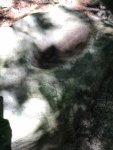Welcome Guest!
You are using an out of date browser. It may not display this or other websites correctly.
You should upgrade or use an alternative browser.
You should upgrade or use an alternative browser.
Is this a grind stone?
- Thread starter Red dirt clod
- Start date
trad bow
wooden stick slinging driveler
If not one it surely could be used as one.
Artfuldodger
Senior Member
How would they make the indention in those stones? I've seen some that were smaller that could be moved and I've seen pics of some made into larger rocks in fixed locations.
GLS
Classic Southern Gentleman
Hard to say without knowing more of its location or size. If it's a boulder weighing hundreds of pounds, was it on high ground where a permanent site for seasonal habitation would have been or was it in or near a stream bed? If it is an unwieldy boulder, was the adjacent ground clear of other boulders that would allow easy and comfortable use along the long axis of the hole which would be the direction of most of the grinding? While not true in all cases, smaller mortars' indentations are typically symmetrical. Point being I've seen some stream boulders with holes and indentations caused by eons of stream forces slowly grinding and shaping boulders in its path. For human activity to do that it would take years and years of grinding. A clearer photo would help. Gil
GLS
Classic Southern Gentleman
Here's a thread depicting a "communal mortar" that I saw in Napa about 6 years ago.
http://forum.gon.com/threads/communal-mortar.718252/
http://forum.gon.com/threads/communal-mortar.718252/
Red dirt clod
Senior Member
Located on a side of the hill, maybe 3 feet by 2 feet wide. Above Cleveland a few miles, creek at bottom of hill. The indention was 10, 12 inches long and maybe 5 inches wide and seemed to be smooth. Maybe 3 inches deep. Seemed an odd place to be located to me. Lots of Oak trees around, maybe used for grinding the white oak acorns. Not far from the house, will take better pictures soon.
GLS
Classic Southern Gentleman
If it is a mortar stone, back then chestnuts would have been supreme. Gil
chehawknapper
ABO
Mortar stones are made by a process called "peck and grind". A "pecking stone" of chert, quartz or diabase is used with glancing blows to slowly crumble the stone over and over in the same area to slowly shape the depression and then ground smooth. The same technique is used to shape celts and grooved axes. Very time consuming but the results last a long time.
GLS
Classic Southern Gentleman
Chehawk, thanks for the insight. Gil
Similar threads
- Replies
- 7
- Views
- 1K
- Replies
- 38
- Views
- 2K
- Replies
- 11
- Views
- 2K

